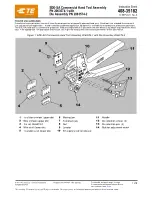
Dismantling & Assembly Instructions
Disconnect tool from air supply.
Grip the flats on cylinder (37) and unscrew safety chuck (40),
quick change chuck (41), spring retainer (42) or needle scaler
attachment (43) according to type fitted. Take out chisel or
adaptor.
Grip cylinder (37) in a vice with handle (21) uppermost and
unscrew handle (21) from cylinder (37). Take off valve assembly
from top of cylinder (37) noting dowel location and separate into
parts pins (32) and (33), valve disc (35), lower valve case (34)
and upper valve case (31). Remove cylinder (37) from vice and
tip out piston (36). Tap out 2 off pins (2) to remove trigger (13)
and screw out regulator (24) and 2 off o-rings (19). Unscrew
intake bushing (27) and remove spring (26), ball (16), push rod
(25) and ball seat (14).
Reassembly
Clean all parts and examine for wear. Replace any components
with parts supplied by the manufacturer or the manufacturer’s
authorised representative. Coat all parts with a pneumatic tool
lubricating oil, one preferably containing a rust inhibitor and
assemble in the reverse order. Fit chisel or attachment as
required.
the 'off' position when it is released.
12) Always shut off the air supply to the tool, and depress the
trigger/lever etc. to exhaust air from the feed hose before fitting,
adjusting or removing the working attachment.
13) Check hose and fittings regularly for wear. Replace if
necessary. Do not carry the tool by its hose and ensure the hand
is remote from the on/off control when carrying the tool with the
air supply connected.
14) Take care against entanglement of moving parts of the tool
with clothing, ties, hair, cleaning rags, etc. This will cause the
body to be drawn towards the tool and can be very dangerous.
15) It is expected that users will adopt safe working practices
and observe all relevant legal requirements when installing, using
or maintaining the tool.
16) Do not install the tool unless an easily accessible and easily
operable on/off valve is incorporated in the air supply.
17) Take care that the tool exhaust air does not cause a problem
or blows on another person.
18) Never lay a tool down unless the working attachment has
stopped moving.
19) Never point a tool at any person.
20) Use only suitable pneumatic tool lubricants. This is important
as a safeguard against the “diesel effect” i.e. explosive mixtures
firing.
21) Chisels worn/blunt at the cutting edge or shank should not
be used as such conditions promote tool breakage, reduce
efficiency and increase vibration. A chisel which breaks can
cause injury by creating unexpected movement.
22) When chipping or scaling in potentially explosive
atmospheres use spark resistant chisels usually made of
beryllium copper. Consult the manufacturer of the tool standard
chisels about sources of supply.
23) Do not store chisels etc. at freezing and below freezing
temperatures. Freezing temperatures can make hardened-tool
steels brittle which can cause breakage and lead to injury.
24) Do not start tool until steel/chisel/needles are in contact with
the working surface. Do not run tool unless retainer is fitted.
25) Always use tool with a whip hose as shown in fig 1.
26) Don’t over reach. Keep proper footing and balance at all times.
27) Do not force the tool but allow it to cut.
28) When possible secure work with clamps or vice so both
hands are free to operate the tool.
29) Use only 0.401” diameter shank size chisels or adaptors.
30) Be aware that prolonged exposure to vibration can cause
injury.
teaspoonful (5ml) of a suitable pneumatic motor lubricating oil
preferably incorporating a rust inhibitor. Reconnect tool to air
supply and run tool slowly for a few seconds to allow air to
circulate the oil. If tool is used frequently lubricate on daily basis
and if tool starts to slow or lose power.
It is recommended that the air pressure at the tool whilst the tool
is running is 90 p.s.i./6.3 bar. The tool can run at lower and
higher pressures with the maximum permitted working air
pressure of 100 p.s.i./7.0 bar.
Page No 2
Safety Rules For A Percussive Air
Hammer
1) Read all the instructions before using this tool. All operators
must be fully trained in its use and aware of these safety rules.
2) Do not exceed the maximum working air pressure.
3) Use personal safety equipment.
4) Use only compressed air at the recommended conditions.
5) If the tool appears to malfunction remove from use
immediately and arrange for service and repair.
6) If the tool is used with a balancer or other support device
ensure that it is fixed securely.
7) Always keep hands away from the working attachment fitted
to the tool.
8) The tool is not electrically insulated. Never use the tool if there
is any chance of it coming into contact with live electricity.
9) Always when using the tool adopt a firm footing and/or
position and grip the tool firmly to be able to counteract any
forces or reaction forces that may be generated whilst using the
tool.
10) Use only correct spare parts. Do not improvise or make
temporary repairs.
11) Do not lock, tape, wire, etc. the on/off valve in the run
position. The trigger/lever etc. must always be free to return to
Operating
Connect tool to clean supply of compressed air at recommended
pressure. Select chisel/attachment to perform the work task and
ensure that the chisel retainer is securely fitted. Do not use tool
without retainer fitted. The power of the tool may be adjusted by
use of air regulator (20). Always ensure that the working tool is in
contact with the workpiece before pressing the trigger. Running
the tool free will reduce tool life by placing unnecessary high
loads on tool retainers and cylinders.






















